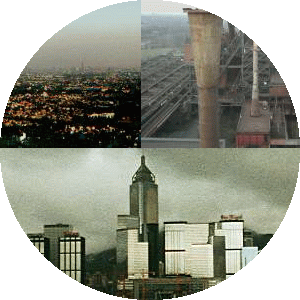 > English > Climate Encyclopaedia > Climate in Cities > more
> English > Climate Encyclopaedia > Climate in Cities > more
|
Climate in citiesMore |
|
The presence of buildings and roads affects the radiation, heat and water balance of an area. This means that the local climate in a city is different to that in the surrounding countryside. Urban bioclimatologists study how the urban climate affects living organisms, particularly humans.
|
|
Air pollution in urban areas affects human health. Energy production, industrial processes and vehicles emit many different air pollutants into the atmosphere. For example acid rain, caused by emissions of sulphur and nitrogen oxides, causes not only soil degradation and lake acidification, but also faster corrosion of metals and decay of buildings constructed of limestone and marble. There have been many attempts to reduce air pollution. Monitoring now occurs in endangered areas and international agreements are now in place which are helping to improve air quality on a global scale.
|
1. Air pollution due to human activity
|
2. Urban climate
3. Acid rain
|
|

